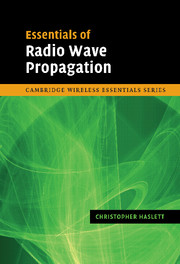Book contents
- Frontmatter
- Contents
- Preface
- Acknowledgements
- 1 Propagation in free space and the aperture antenna
- 2 Point-to-area transmission
- 3 The effect of obstacles
- 4 Reflection, scatter and penetration
- 5 Estimating the received signal strength in complex environments
- 6 Atmospheric effects
- 7 System design and interference management
- 8 Software-based tools
- 9 Summary
- Appendix 1 The decibel scale
- Appendix 2 Phasor arithmetic and phasor diagrams
- Appendix 3 Formula sheet
- Appendix 4 Explanation of the link budget
- Further reading
- References
- Recommendations of the Radiocommunication Bureau of the International Telecommunications Union (ITU), Geneva
- Author's biography
- Index
1 - Propagation in free space and the aperture antenna
Published online by Cambridge University Press: 09 August 2009
- Frontmatter
- Contents
- Preface
- Acknowledgements
- 1 Propagation in free space and the aperture antenna
- 2 Point-to-area transmission
- 3 The effect of obstacles
- 4 Reflection, scatter and penetration
- 5 Estimating the received signal strength in complex environments
- 6 Atmospheric effects
- 7 System design and interference management
- 8 Software-based tools
- 9 Summary
- Appendix 1 The decibel scale
- Appendix 2 Phasor arithmetic and phasor diagrams
- Appendix 3 Formula sheet
- Appendix 4 Explanation of the link budget
- Further reading
- References
- Recommendations of the Radiocommunication Bureau of the International Telecommunications Union (ITU), Geneva
- Author's biography
- Index
Summary
This chapter introduces the basic concepts of radio signals travelling from one antenna to another. The aperture antenna is used initially to illustrate this, being the easiest concept to understand. The vital equations that underpin the day-to-day lives of propagation engineers are introduced. Although this chapter is introductory in nature, practical examples are covered. The approach adopted is to deliver the material, together with the most significant equations, in a simplified manner in the first two subsections before providing more detail. Following this, the focus is on developing methods of predicting the received signal power on point-to-point links given vital information such as path length, frequency, antenna sizes and transmit power.
Propagation in free space: simplified explanation
Radio waves travel from a source into the surrounding space at the ‘speed of light’ (approximately 3.0 × 108 metres per second) when in ‘free space’. Literally, ‘free space’ should mean a vacuum, but clear air is a good approximation to this. We are interested in the power that can be transmitted from one antenna to another. Because there are lots of different antennas, it is necessary to define a reference with which others can be compared. The isotropic antenna in which the transmitted power is radiated equally in all directions is commonly used as a reference. It is possible to determine the ratio between the power received and that transmitted in linear units, but it is more common to quote it in decibels (dB).
- Type
- Chapter
- Information
- Essentials of Radio Wave Propagation , pp. 1 - 25Publisher: Cambridge University PressPrint publication year: 2007



